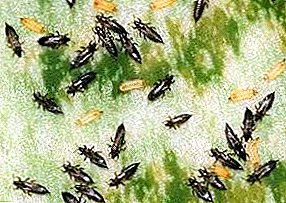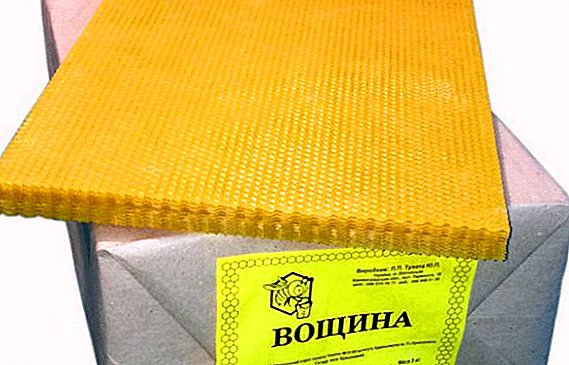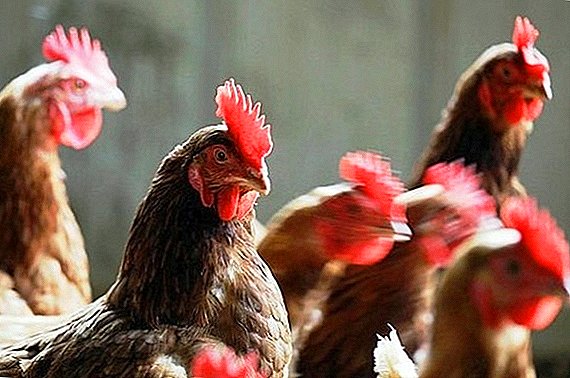 A person who breeds chickens for eggs and meat in his plot must not only learn the rules of their breeding and housing, but also have an understanding of the diseases that can affect his feathered pets. And not only to know about them, but also to be able to react in a timely and correct manner so as not to miss the birds dangerous for life, as well as for human health, conditions. This material deals with a common disease called egg production-76 syndrome.
A person who breeds chickens for eggs and meat in his plot must not only learn the rules of their breeding and housing, but also have an understanding of the diseases that can affect his feathered pets. And not only to know about them, but also to be able to react in a timely and correct manner so as not to miss the birds dangerous for life, as well as for human health, conditions. This material deals with a common disease called egg production-76 syndrome.
Egg reduction syndrome virus
There are diseases of poultry that are transmitted from one species to another with no apparent symptoms until the victim is found to be susceptible to the causative agent of the disease.
Did you know? Chickens were first domesticated about three thousand years ago in the territory where modern Ethiopia is located.
Syndrome reduction in egg production-76 (EDS-76) was first discovered and described in the Netherlands in 1976. It is believed that the ducks are borne by the virus: domestic and wild, however, they themselves are not susceptible to the disease.
The fact that antibodies to the pathogen were not detected in serum samples obtained from chicken blood before the specified year is considered to be evidence that it was during this period that the disease occurred.
Subsequently, the virus strains, identical to the original, strain-127, were isolated in various progressive countries: England, France, Italy, Japan, Hungary. This means that the detected disease has spread throughout the world.  EDSL-76, or adenovirus disease (Egg drop Syndrome-76), is characterized by the fact that in laying hens egg production decreases due to damage to the reproductive system, egg shape changes, its quality deteriorates, the shell is fragmentarily depigmented and softens or is completely absent, broken protein structure.
EDSL-76, or adenovirus disease (Egg drop Syndrome-76), is characterized by the fact that in laying hens egg production decreases due to damage to the reproductive system, egg shape changes, its quality deteriorates, the shell is fragmentarily depigmented and softens or is completely absent, broken protein structure.
We advise you to read about how to increase egg production in chickens in winter, as well as what vitamins chickens need for laying eggs.
The causative agent of this pathology is the DNA-containing adenovirus (Adenoviridae), hence another name for the disease. This microorganism does not belong to the known types of adenoviruses of feathery and is capable, in contrast to those mentioned, to the agglutination gluing of erythrocytes of many, including domestic, birds.
Did you know? The chicken will not trot in the dark, even if the time is right for it. She will wait until the day comes or the lights come on.

After the chicken has suffered this disease, it acquires antibodies that are able to transmit to the offspring through eggs.
The microorganism is sensitive to formaldehyde, but it can not be destroyed:
- ether;
- chloroform;
- trypsin;
- phenol solution 2%;
- alcohol solution 50%.
At 50-degree temperature, it is active for 3 hours, at 56-degree - one hour, at 80-degree - half an hour. It is known that the pathogen multiplies in the epithelial cells of the oviduct and at the same time the formation of the eggshell of normal quality is disturbed.
Did you know? A one-day-old chicken has a set of reflexes and skills that correspond to the set of a three-year-old human child.

We recommend reading about the diseases of chickens and methods of their treatment.
A bird that has had a disease after recovery may experience:
- oviduct edema and atrophic processes in them - shortening and thinning;
- in some cases - cysts;
- changes in the liver: increase in size, yellowing, loose structure;
- increase and liquid filling of the gallbladder.
The causes of the disease
A chicken of any breed and any age can get sick, starting from a productive one, however, the “favorite” age for the manifestation of the virus is the peak of chicken productivity: 25-35 weeks. Great susceptibility to it is shown by breeding chickens, as well as layers belonging to the meat type.
The manifestations of the disease are the brighter, the higher the productivity is expected from the individual in accordance with its breed characteristics.  Adenovirus, transmitted transovarially (through an egg laid by an infected hen), may asymptomatically remain in the body of a young bird until its body experiences stress, such as the onset of egg-laying. At the right time for him, he is activated, reducing chicken egg production. This mode of transmission is called vertical.
Adenovirus, transmitted transovarially (through an egg laid by an infected hen), may asymptomatically remain in the body of a young bird until its body experiences stress, such as the onset of egg-laying. At the right time for him, he is activated, reducing chicken egg production. This mode of transmission is called vertical.
It is noteworthy that in the first days of life, a hen bred from an infected egg or infected with the causative agent of EDSN-76 will not demonstrate vivid manifestations of the syndrome at the peak of productivity, however, it’s not possible to expect a high egg production rate.
There is also the possibility of horizontal infection:
- contact - through the clothes and shoes of people, transport, household items and care;
- sex - through the sperm of a rooster;
- fecal-oral - through droppings and discharge from the nasal and oral cavities of infected individuals;
- by vaccinating birds for other diseases.

The carriers of the causative agent of EDSN-76 are infected, as well as recovered chickens, ducks and geese, both domestic and wild, as well as other waterfowl. Through infected feces, wild birds can carry the disease over long distances.
Important! In the case when the bird is kept crowded, in close contact, the spread of the virus is greatly accelerated and infection of the entire herd can occur in 1-14 days. Conversely, layers isolated from each other by partitions can remain healthy for a long time, even when they are close to an infected individual.
Economic damage
EDS-76 brings significant economic damage to both private farms and large industrial farms. During the disease, culling from one layer is 10-30 eggs, and in breeding birds it reaches 50. This means 17-25% damage.  To restore the productivity of one individual takes from 4 to 6 weeks, if it is contained in a cage. In chickens kept on the floor and in contact with other individuals and their biological material, egg production may not recover to the initial level of 6-12%.
To restore the productivity of one individual takes from 4 to 6 weeks, if it is contained in a cage. In chickens kept on the floor and in contact with other individuals and their biological material, egg production may not recover to the initial level of 6-12%.
As for hatching eggs laid by infected individuals, many of them are simply unsuitable for breeding due to too fragile shells. In addition to the fact that a large percentage of them are culled at the initial stage, hatchability decreases. Their survival rate in the first days after hatching was also lowered.
Read the rules for chick breeding using an incubator, and learn how to lay eggs in an incubator.
Although in our time there is much more information about this disease, as well as accumulated enough experience in the struggle compared to 1976, some questions are still controversial and do not have a definite answer.
Important! The syndrome is widespread in those countries that use highly developed industrial technology of poultry farming, and the greatest damage is caused to breeding farms.

Symptoms
Before the beginning of the productive age in an infected individual, the pathogen resides in the intestine and does not manifest itself. When the time comes and the hormones of the chicken change to ensure egg production, the virus is activated and the stage of viremia begins, that is, the virus circulates in the body through the bloodstream.
We recommend that you familiarize yourself with the symptoms and treatment of chickens such as conjunctivitis, pasteurellosis and colibacillosis.
Reaching the epithelium of the mucous membrane of the oviduct, the virus contributes to the imbalance of minerals: sodium, potassium, magnesium, calcium and others, as a result of which the chicken lays eggs that are too thin, deformed, or even completely absent.
Did you know? The rooster in the chicken herd, in addition to its reproductive role, performs a number of important social and administrative functions: control over the regime of the day, conflict prevention, protection from danger, even if the enemy deliberately surpasses it in strength and size.

For all the seriousness of the infection, chickens rarely show any signs of disease.
Occasionally, often in a minor form, can be observed:
- signs of general intoxication - weakness, fatigue, and others;
- decreased appetite;
- diarrhea and the presence of green in the litter;
- anemia;
- weak breathing at the peak of an acute condition;
- bluish shade of scallops and earrings.
The main symptom and symptom is a sharp decrease in productivity, carrying thin, deformed eggs of very poor quality. The protein of this product is watery and cloudy. Chickens bred from these eggs have low viability and die in large numbers in the first days of their lives.  Symptoms may vary depending on the breed of chicken:
Symptoms may vary depending on the breed of chicken:
- "fatty egg" and a reduced quality of the shell is more common in brown crosses and broilers;
- protein change. His liquefaction and turbidity is more characteristic of white crosses.
Important! Fall is not a characteristic sign of this disease, its level is rarely above 5%. The cause is mainly yolk peritonitis.
Diagnostics
In order to make a preliminary diagnosis and keep a follow-up account, graphs should be developed to demonstrate the development of egg productivity, taking into account the fact that, due to adenovirus, a decrease in egg production occurs in a layer of 200-240 days of age.
In the case of a drop in productivity in an individual older than 300 days of age, the reason is most likely some other factor.  In any case, before making a diagnosis of egg drop syndrome-76, it should be excluded:
In any case, before making a diagnosis of egg drop syndrome-76, it should be excluded:
- Newcastle disease;
- coccidiosis;
- infectious etiology bronchitis;
- helminthic invasion;
- poisoning with various substances;
- inferiority of the diet;
- other factors that may provoke a decrease in egg productivity.
How and where to turn
If the virus is detected at an industrial enterprise, the farm is transferred to the category of dysfunctional and impose appropriate restrictions: measures for mechanical cleaning and disinfection, vaccination, culling, and the like.
Finding a chicken with suspicion of EDS '76 in a private chicken coop is a reason to invite a veterinarian who will examine and vaccinate and give recommendations. 
What surveys will be conducted
The diagnosis of "adenoviral infection" is made on the basis of research:
- epizootological;
- clinical;
- pathoanatomical;
- laboratory.
For analysis in the laboratory examine:
- oviduct;
- ovaries with follicles;
- the rectum and its contents;
- blood;
- washings from the nasopharynx and cloaca.
It is preferable to conduct research in the first days of the disease (3-5 days), and use material from birds that died or slaughtered no more than 2 hours ago. 
It will be useful for you to read about what to do if the chickens are badly rushing and pecking eggs, do you need a rooster so that the chickens would carry the eggs when the young hens begin to rush.
Blood for the isolation and study of its serum is advisable to take from individuals of the following groups (15-20 samples from each):
- 1-200-day individuals;
- 160-180-day individuals;
- 220-day individuals;
- 300-day individuals;
- older individuals retired;
- specimens with signs of disease.
Did you know? Chickens have their own “tongue”, capable of transmitting about 30 different signals with the help of sound to other individuals. There is even a “mother” language with which the hen communicates with the offspring. Moreover, the not yet hatched chicken a few days before this event communicates with the hen through the shell, using up to ten different signals.

As for eggs, it is advisable to investigate namely substandard samples with a violation of the structure of the shell and / or content.
How to treat
As with many other viral diseases, there is no specific treatment. It is recommended to focus on the usefulness of the diet, its saturation with essential amino acids, vitamins and minerals. The production of antibodies begins on the 5-7 day of the disease and lasts for 2-3 weeks, after which the individual receives a lifelong immunity.
Many are looking for answers to such questions: how long a chicken lives, how to determine the age of a chicken, how to determine the sex of a chicken, why chickens go bald and fall to their feet.
The necessary measures include the mandatory isolation of the first diseased layers from the rest of the herd, especially if floor keeping is practiced. It is necessary to monitor the rest of the bird for signs of symptoms.
If the nature of the disease is not a single, quarantine measures are necessary. A poor bird is subject to slaughter, biological material taken from it is sent for analysis for laboratory confirmation of the diagnosis. 
For the disinfection of the coop often use the drug "Brovadez-plus."The coop is treated and disinfected with a 2% formaldehyde solution. Eggs for incubation are used after a 2-month break. At the very beginning of the disease it is advisable to introduce a vaccine: liquid sorbed or emulsified inactivated.
Important! It is very important to track the onset of the disease and not to start the situation: this can help to avoid many problems associated with the spread of the virus in the chicken herd.
This measure may be effective for skipping the viremia phase - the spread of the virus through the bloodstream through the body. Consequently, the pathogen will cause less harm to the bird, it will not be present in the secretions of the body, in addition, this measure allows to improve the quality of eggs and bird productivity. 
Prevention and vaccine against the virus
Vaccination is used to prevent such an unpleasant disease as egg-lowering syndrome-76, which prevents the viremia phase, which improves the productivity and quality of the eggshell.
16–20 weeks old individuals are vaccinated, injecting the drug subcutaneously or intramuscularly, and after 2 weeks the bird develops immunity lasting one year.
The following vaccines are used for immunization:
- liquid inactivated;
- emulsified inactivated;
- associative inactivated.

Preventive measures are based on the implementation of veterinary and sanitary regulations in order to prevent the introduction of the pathogen from the external environment. For hatching eggs, eggs taken from layers above 40 weeks of age are used, and you should first make sure that their analyzes are normal.
Read more about how to choose the right chicken coop when buying, how to equip it, how to make a chicken coop from a greenhouse, how to make ventilation in it, how to build a chicken coop for the winter, and also how best to heat the chicken coop in winter.
The bird in whose blood the pathogen is found is slaughtered. The fact of detecting a virus indicates its presence on the premises. In this case, you need to monitor your chicken coop and take the necessary measures in time.
To reduce the risk of an outbreak in your hen house, you need to:
- comply with sanitary standards;
- contain birds separately by age groups;
- separately keep the chicken herd from the goose and duck;
- clean and disinfect the room from time to time, as well as inventory.
Did you know? Chickens are capable of emotions: sympathy, sadness. In addition, they have a sufficient level of intelligence to remember the appearance of about a hundred other creatures, as well as use existing experience and information about the environment, making decisions.
It is much cheaper than prevention of treatment of the disease. Even in a small chicken coop, it is necessary to adhere to the norms of keeping and in time to isolate the bird in case of suspicion of its disease. In many cases, compliance with simple and logical rules protects the poultry farmer from unpleasant diseases and their consequences.












